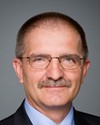Good morning, everyone.
I am the director general of the Centre for Immunization and Respiratory Infectious Diseases at the Public Health Agency of Canada.
I played many roles during the time of the pandemic, as did the person who is accompanying me, Dr. Frank Plummer, who is the chief science adviser at the agency and also the director general of the National Microbiology Laboratory in Winnipeg.
We're here today to talk to you about the epidemiology of pandemic influenza and the role the agency plays in planning and preparing for a pandemic.
We will speak also about the way decisions were made about who was to be prioritized for vaccination and the moment and time that actually occurred. We'll talk at the end about some of the lessons we learned following the last pandemic and the go-forward in terms of our planning activities.
The federal government plays a leadership role in providing guidance to decision-makers to help inform response efforts. We work very closely with provinces and territories through the Pan-Canadian Public Health Network and the Council of Chief Medical Officers of Health. As has already been identified, Dr. Corriveau and Dr. Strang will be providing some information from their perspective as well.
I'll begin by explaining the importance of epidemiology in a pandemic.
People are exposed to different strains of influenza virus throughout their lives. The influenza viruses usually change, if only a little bit every year, and our immune systems adapt to these small changes, either as a result of vaccination or because we have what are generally mild infections. However, three to four times a century, the influenza virus undergoes a major change, causing a new strain to emerge for which humans may have no immunity. This is what leads to a pandemic, which generally causes a more severe disease than seasonal flu.
There were three influenza pandemics in the 20th century, one in 1918, one in 1957, and one in 1968. We've already had the first one in this century, in 2009. Each of these pandemics has differed markedly in severity, duration, and the populations most affected.
In 1918, for example, the Spanish flu was one of the deadliest, if not the deadliest, natural disasters in human history, in that it caused upwards of 50 million deaths. Some people have estimated that it may have actually caused 100 million deaths. Most of the victims were healthy young adults, in contrast to influenza outbreaks, which predominantly affect the young, the elderly, and persons with underlying chronic health conditions that put them at greater risk of severe disease.
The Hong Kong pandemic in 1968 caused an estimated one million deaths worldwide. In this case, it mostly affected the elderly, those 65 and older.
The virus responsible for the 2009 H1N1 pandemic was again different. This time, approximately 300,000 people globally died from the disease. Interestingly, many were younger people who were otherwise healthy.
You may recall that Canada played a leadership role in understanding and responding to the virus. Our laboratory and scientific expertise allowed the agency to decode the genetic makeup of the Mexican strain of the H1N1 flu virus.
The agency also assisted Mexico with diagnostic testing of clusters of severe respiratory disease in April 2009. Over 400 specimens from the ministry of health in Mexico were tested. Shortly thereafter, our National Microbiology Laboratory developed a test that allowed researchers to determine whether the strain of influenza involved was a common regular strain of seasonal flu or actually the new H1N1 virus.
The agency then, in collaboration with the provinces and territories, rolled out a national surveillance activity to track confirmed cases of the H1N1 virus in Canada.
At the same time, the agency was working with international partners. It sent officials, including epidemiologists and lab researchers, to Mexico to assist in the early investigation of the H1N1 outbreak. The investigations that were done there actually helped us a great deal in Canada, as well as other countries, in that we were able to better understand the transmissibility of the virus.
Our successful response to the H1N1 outbreak was, in great part, attributable to our advance planning. Canadian governments and public health organizations had been working together for many years to prepare for a pandemic. Canada was one of the first countries in the world to have a pandemic plan. Our first plan was actually developed in 1988.
The goals of pandemic preparedness and response in Canada have been, and continue to be, twofold: first, to minimize serious illness and overall deaths, and second, to minimize disruption to our daily lives.
The Canadian pandemic influenza plan for the health sector, which I will call the CPIP, maps out how the health sector can prepare for and respond to a pandemic influenza. It is a federal-provincial-territorial framework and the Public Health Agency of Canada is considered its custodian.
While the latest version was published in 2006 and consists of a main body and 16 annexes, it is important to note that a number of these annexes were updated in as late as 2009. These annexes address key aspects of the pandemic preparedness planning and response in greater detail and cover vaccines, antivirals, communications, and surveillance, among many other issues.
The 2006 CPIP was developed under the governance of the Pan-Canadian Public Health Network Council. It is the result of extensive federal-provincial-territorial dialogue and collaboration with a very wide group of stakeholders.
The CPIP is available on the Public Health Agency website. We have provided the link in the information note to committee members, as well as a copy of annex D from the pandemic plan, “Preparing for the Pandemic Vaccine Response”. That is actually dated September 2008 and was amended after the initial plan was published in 2006. This annex includes a prioritization framework that outlines the factors to be considered when developing priority access strategies, but it does not prioritize any group.
Population subgroups are identified within the vaccine annex. Under the subgroups entitled "key societal decision makers" and "pandemic societal responders", reference is made to fire chiefs and firefighters as examples of who would make up these groups.
As a pandemic is evolving, experts have to consider many factors in determining recommendations for priority access to vaccines. Factors include consideration of the severity and epidemiology of the pandemic, that is, who is most likely to be affected in terms of illness, complications, and death. Factors also include ensuring business and societal continuity and consideration of vaccine availability. In other words, during a pandemic, a risk management approach must be used to inform decisions. Guidance must allow for flexibility and latitude to enable jurisdictions to take into consideration their particular circumstances.
During the H1N1 outbreak, the epidemiology of the virus showed that some Canadians, that is, pregnant women, children less than five years of age, and people with underlying health conditions, were at higher risk of developing serious illness and death. It was those people and their caregivers who went to the top of the list when developing the pan-Canadian recommendations.
The list identified primary, secondary, and tertiary targets. Those who were at greatest risk were primary targets, along with their caregivers and health care workers. Secondary targets included firefighters; they were right behind those at most risk. That list, dated September 10, 2009, has also been provided to the committee members.
Taking into consideration the list and the rationale provided for priority access, provinces and territories then made their own decisions based on what was occurring in their particular jurisdictions.
Manitoba and Yukon chose to allow firefighters to be immunized within the first week of vaccination clinics. Others gave higher priority to vaccinating schoolchildren.
The 2009 pandemic was the first major public health event to test the CPIP and Canada's pandemic response generally. Reviews played an important role in paving the way to ensure that we are even better prepared the next time around. One of the reviews was undertaken by the Senate Standing Committee on Social Affairs, Science and Technology, at the request of the Minister of Health.
Overall, the Senate committee concluded that pandemic planning was successful. It did recommend that the agency collaborate with the provinces and territories on revisions to the CPIP that would allow for a more scalable response to address particular pandemic epidemiology. That way, the CPIP would more easily be adaptable to mild, moderate, and severe pandemics.
In this regard, the agency has been working with provinces and territories to review the CPIP and to revise it as required. This work is being conducted over a three-year period and will include consultations with all key stakeholders, including firefighters.
The revised CPIP will be tested on an ongoing basis to ensure that Canada maintains its ability to prepare for and respond to any emergencies that might threaten the health and safety of Canadians.
We continue to dialogue with the provinces, territories, and principal stakeholders, notably, the organizations that represent first responders, to enable us to prepare for a pandemic and to develop our activities in general that allow for a pandemic response.
I thank you for the opportunity to speak on the issue.













